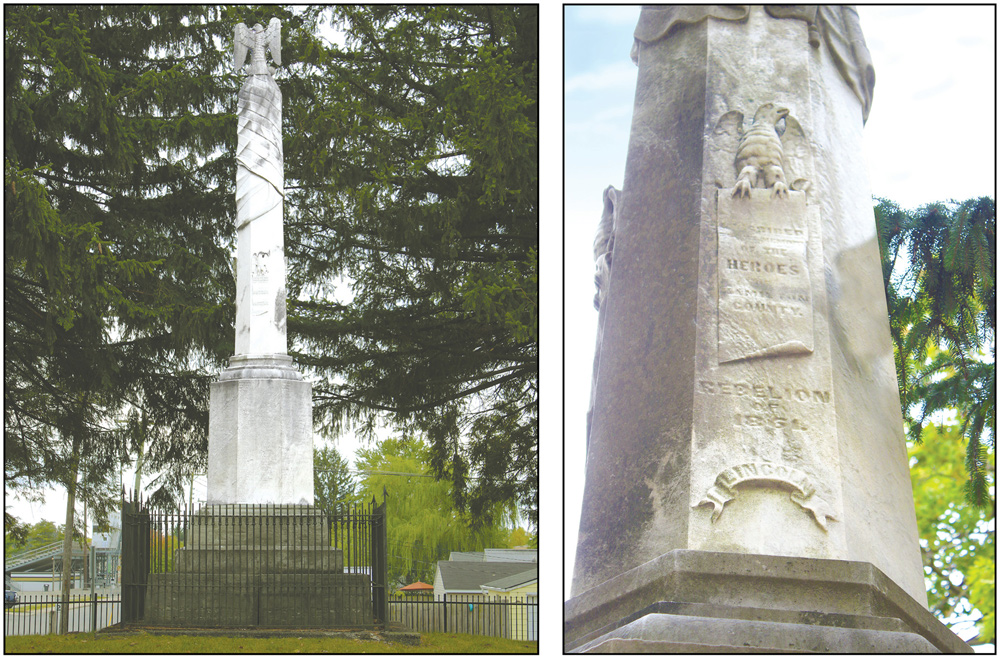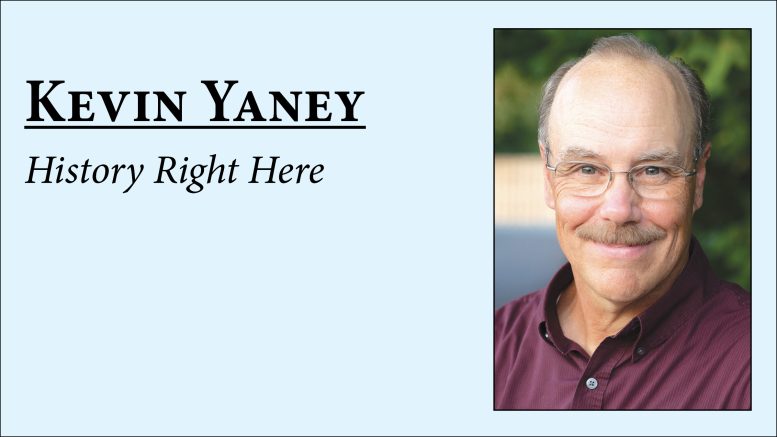The history of Hamilton County leading up to the American Civil War is quite remarkable. We are surrounded by the historical evidence of the most tumultuous time our nation has faced, but often, it has become so familiar that we don’t recognize it.
A good example is the Civil War Monument that is inside Crownland Cemetery in Noblesville.
If you are ever wondering where Noblesville’s Monument Street got its name, take a look behind the giant pine trees that grow in the cemetery near the corner of Monument and Harrison streets. There you will find the 28.5-foot marble “Register of the Heroes of Hamilton County,” who volunteered to go to war to put down the “Rebellion of 1861,” as they referred to what we commonly call the Civil War.

The “Register of the Heroes of Hamilton County.” (Photos provided)
The tribute was dedicated on July 4, 1868, a mere three years after the war ended. The ceremony included speeches by the governor of Indiana, Conrad Baker, and other dignitaries. One person who spoke would be quite familiar to everyone in attendance that day: Major John D. Evans. If you can make out the carved names on the weathered marble of the shrine, you will find Evans’ name among the officers, but he was much more than that to those in attendance. He was the man who recruited men from Noblesville to enter this war shortly after the opening shots were fired at Fort Sumter.
To get a picture of what was happening in April of 1861, you have to go back to November 1860. That’s when the Republican, Abraham Lincoln defeated three other candidates and was elected to be the 16th President of the United States. Lincoln’s election was polarizing. Although he won the popular vote in Indiana (winning Hamilton County with over 70 percent), the Republican’s stance on slavery kept him off the ballot in many southern states. After his victory, seven states voted to leave the Union. By February 4, 1861, they began meeting to draw up a new constitution.
Just 39 days into Lincoln’s presidency, a South Carolina militia fired upon Fort Sumter in Charleston harbor. Three days later, on April 15, 1861, Lincoln issued a call to arms for 75,000 volunteers to help quell the rebellion. He asked them to volunteer for military service for three months (little did anyone know this war would last for four years).
Lincoln’s action was divisive. Virginia, North Carolina, Tennessee, and Arkansas all left the Union rather than take military action against the Confederacy. The Kentucky legislature declared itself neutral over the issue and refused to send any volunteers to aid the cause of the Union. However, in Indiana, the response was quite different.
Each state was given a quota of fighting volunteers to raise up for the Union’s cause. Indiana’s portion of the 75,000 volunteers was to be 4,683. Within one week, over 12,000 men showed up in Indianapolis to volunteer for the military service – nearly three times what was required!
That’s where we meet John D. Evans.
Evans had been born in slave-holding Kentucky but moved to Indiana. When the call to arms was issued, Evans helped recruit 67 men to form a company originating in Noblesville – the Hamilton Continentals. They eventually became Company I of the Sixth Indiana Volunteer Regiment. He was selected to be their captain. Why is this significant?
First, understand that among the volunteers, there were three men for each company to be commissioned as officers (one captain and two lieutenants). These men were elected, not appointed, into these roles by the men they led. That meant they were leaders in the community in some fashion before they were leaders of soldiers.
Secondly, the Indiana 6th was the very first regiment to form in Indiana and be sent to war. Regiments 1 through 5 had fought in the Mexican War, so, to avoid confusion, the Civil War regiments from Indiana began with the Indiana 6th. The Indiana 6th was sent into what is now Philippi, W.V., to oust a Confederate militia, which they did in some of the earliest engagements in the war. By the end of July, they had ended their three months of service and were welcomed back to Indianapolis.
However easy these military operations in West Virginia were, the same could not be said for a larger engagement on July 21, 1861, about 30 miles southwest of Washington in a small place called Manassas Junction. That’s where our story will pick up in Part 2.
If you would like to know more about the Civil War Veterans from Noblesville, join us for a walking tour at 11 a.m. on Veterans Day, Nov. 11 at Crownland Cemetery. For more information, go to CivilWarVeteransWalkingTour.com.


Kevin , I enjoyed reading. I will be there in November for the walk. Denny Miessen